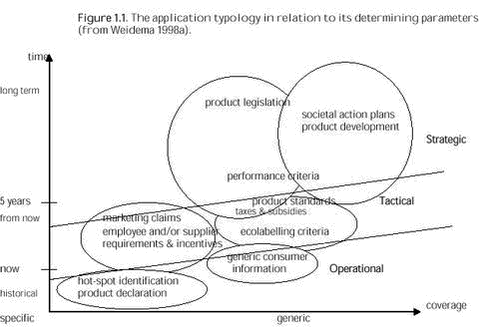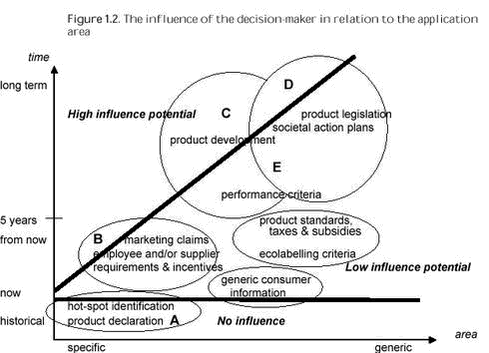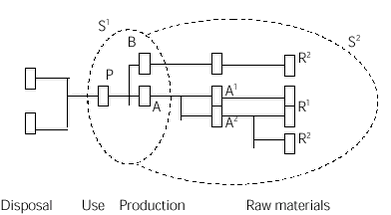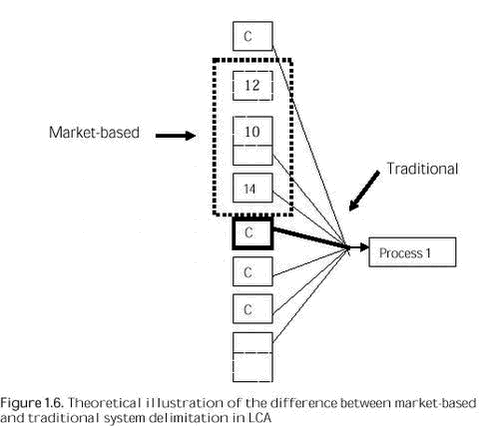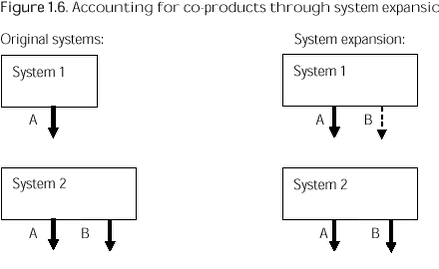Market information in life cycle assessment
1 Introduction1.1 The relation between application areas and methodology1.2 Discussion of attributional versus consequential LCA 1.3 Product substitution 1.4 Defining the functional unit 1.5 Market-based system delimitation 1.6 Handling co-production 1.7 Forecasting processes 5 This report provides the background for the two guidelines “The product, functional unit, and reference flows in LCA” (Weidema et al. 2003a) and “Geographical, technological and temporal delimitation in LCA” (Weidema 2003). It provides further documentation of the examples provided in these guidelines, as well as additional examples, further explanatory text, scientific background and reference to earlier methodological guidelines. It also expands on specific issues, which were not found to be of sufficient general interest to merit inclusion in the guidelines. This report and the two guidelines that it supports, carry two key messages: 1. The fundamental rule to apply in all methodological choices in life cycle assessment is that the data used must reflect as far as possible the processes actually affected as a consequence of the decision that the specific life cycle assessment is intended to support. Thus, there is a close link between the goal or application area of the life cycle assessment and the methodological choices. This is elaborated in section 1.1. 2. Life cycle assessments, insofar as they deal with comparing potential choices between alternative products, rely heavily on market information, i.e. information on how the market affects the potential choices and how the markets will react to these choices. Whenever possible, the above understanding has been converted to practical, step-by-step procedures for including market information when:
For all these elements of the life cycle assessment methodology, the inclusion of market information leads to improvements, which also reduces the uncertainty of life cycle assessment results. While the methodological improvements are described in this report, the consequences for uncertainty are the topic of a separate report: "Reducing uncertainty in LCI. Developing a data collection strategy" (Weidema et al. 2003). 1.1 The relation between application areas and methodologyThe methodological elements listed above are fundamentally determined by the temporal and spatial aspects of the studied systems and by the products and interest groups affected. On this basis, six well-defined application areas can be distinguished (see figure 1.1). The decision-maker‘s potential influence on the different processes in the product systems increases towards the top left of the diagram, i.e. as the decision horizon becomes more long-term and as the decision relates to more specific products and geographical areas. This is further illustrated in figure 1.2. For retrospective studies (area A in figure 1.2), there is no choice to influence. For medium-term, tactical studies, high influence on specific processes throughout the life cycle is limited to studies where the product systems are very well-defined and where the decision-maker already at present has a high influence on the other actors in the life cycle (illustrated by area B in figure 1.2). Tactical aspects (i.e. contacts to be made in the product chain) may also be part of the considerations in product development, and the more long-term the development, the more ambitious one may be with respect to obtaining influence (area C). Even on a societal level, it may be possible to influence specific choices throughout the life cycle, when the products are relatively well-defined and have well-defined interest groups (including producers and users), and when the time horizon is long enough to allow the necessary regulative and technical infrastructure to be developed (area D). For the rest of the applications (area E in figure 1.2), the products are either too generic (i.e. includes several products or a group of products) or involve too many interest groups to allow a decision-maker to influence specific choices throughout the life cycle. With respect to methodological choices, the most important distinction is that between the retrospective, attributional life cycle assessments of the accountancy type6 (typically applied for hot-spot-identification, product declarations and for generic consumer information) and the prospective consequential life cycle assessments, which study the environmental consequences of possible (future) changes between alternative product systems (typically applied in product development and in public policy making) (Tillman 1998, 2000). This distinction is further elaborated in section 1.2. The application areas (as outlined in figure 1.1) affect the methodology in the following ways:
Thus, for each application area of figure 1.1, we can outline the conditions for the methodological choices to be taken:
Note that when defining the goal and scope of an attributional LCA, one should be aware whether one intends later to use the results for decision making, in which case it should be carefully considered whether it is necessary and worthwhile to perform an attributional LCA or whether a consequential study is adequate and sufficient. See also the discussion in section 1.2.
Unfortunately, the above recommendations are not in complete accordance with the recommendations from the Dutch methodology project (Guinée et al. 2001), which was carried out simultaneously with the Danish project of which this report is a result. In spite of close agreements on many important basic concepts (see Guinée 1999) we did not succeed in reaching consensus on the specific recommendations to be given in our respective guidelines. The main differences between the guidelines are that the Dutch guideline restricts its recommendations to a baseline situation (applications with small, long-term consequences), and recommends an intentional disregard for market mechanisms and their consequences. In relation to the definition of the functional unit, the latter recommendation implies an assumption that there are no changes in consumer behaviour in relation to product substitutions, such as the so-called “rebound effect”, and that differences in consumer prices do not induce the consumer to spend more or less money on other products. In relation to system delimitation, it implies an assumption that all processes will react to changes in demand in proportion to the revenue obtained for the production (i.e. that relative supply elasticities equals relative prices) without any side-effects, so that the affected technology will be the average of the currently installed technology, and so that co-production does not lead to substitution and may therefore be handled by economic allocation. The argument for this intentional disregard for market mechanisms is apparently that a full modelling of market mechanisms is not practicable, and that using an incomplete model of market mechanisms may introduce large uncertainties in the modelling. Thus, the Dutch guideline opts for an incomplete description rather than an uncertain description of the markets. In this way, there is an inconsistency between the Dutch recommended methodology and the application area for which it is suggested (consequential studies), as also pointed out by several of the international reviewers (Guinée 1999). In section 2.4 we continue the discussion on the issue of market modelling, and provide further arguments for intentionally including market mechanisms and their consequences. 1.2 Discussion of attributional versus consequential LCAThe relevance of attributional LCAs has been questioned (Weidema 1998b, Wenzel 1999), because the ultimate goal even of hot-spot-identification and product declarations is to improve the studied systems:
Even a question that appears retrospective at first sight (like “If I look at the world as it is now, what is the environmental contribution of car driving?”, Guinée 1999, p.5) does not appear to have a meaningful answer, except if we reformulate it as a hypothetical “historical, consequential”: “What would the world have looked like now, if we had removed car-driving?” Such historical consequential questions can be answered by applying the same consequential methodology as for prospective questions, but using current or historical data. As pointed out by Guinée et al. (2001, part 3, p. 14), outside such a consequential context, there is no objective way to separate the system of car driving from the rest of the technosphere (i.e. to draw the dotted line in the left circle in figure 1.3), since all product systems are ultimately linked (i.e. there are so many lines crossing the dotted line in the left circle in figure 1.3 that the drawing of this line will imply a number of normative cut-offs). Thus, outside of a consequential context, any separation of product systems will be inherently normative and will therefore have to be included in the question asked, i.e.: “Providing we use method X for dividing car driving from the rest of the technosphere, what is its environmental contribution?” implying that the question carries the premises for its own answer. Such questions, and the LCAs that are used to answer them, may therefore more correctly be termed attributional (Heijungs 1997, Frischknecht 1998, Hofstetter 1998) than retrospective, since they deal rather with the juridical issue of allocation or attribution of guilt, blame or responsibility, than with the natural science issue of analysing causalities and consequences, and since such questions of guilt, blame or responsibility may pertain to the future as well as the past. The term retrospective, if used at all, should then rather be used for the “historical consequential” applications (see also figure 1.4). The point made here is not that attributional questions are meaningless, but that it is impossible to give meaningful, objective answers to such questions. In terms of uncertainty, this may be considerable in consequential LCA, since current uncertain knowledge is used to assess future consequences. However, this uncertainty can be estimated and controlled, while the error that is inherent in attributional LCA is fundamentally unknowable and uncontrollable. In the past, life cycle assessments have primarily been applied to consequential questions, and practitioners have sought to adjust their methodologies to reflect this objective. However, attributional methodologies have often been applied, because adequate consequential methodologies have been missing. We hope that the market-based methods presented in this report will help practitioners to apply a consequential approach more consistently throughout their life cycle studies. The relevance of attributional LCAs have been defended with a number of different arguments, which will be treated separately here:
If a company or product chain in an expanding market has several production lines, some older more polluting and some new less polluting, it may appear with a below average environmental performance in an attributional LCA that use average data, while a consequential LCA that focus only on the new production lines that will be installed, may show a performance equal to the rest of the market, since all actors on the market typically install the same new technology. It may be argued that an attributional LCA will provide an incentive for improvement of the older, more polluting production lines, in order to better compare with “green” competitors that have only newly installed production lines, while the consequential LCA does not provide the same incentive. The attributional LCA can be said to reward the newcomer that is not burdened with the old technology, while the older factory is punished for having been in business longer. However, there is a way for the older factory to avoid this, namely by separating the old and the new parts of the factory, selling the products from the old production lines to the general customer, and selling the now competitive products from the new production lines on the “green” market. This restructuring would not change the overall environmental impact and the attributional LCA would not have provided any more incentive for improvement than the consequential LCA. In contrast, consequential LCA does provide a real possibility to reward improvements in older production lines even when these are not immediately affected by changes in demand. This is possible if the producer actively links his improvements in the older production lines to increases in sales. Thereby, the customer buys both a product from the new production line and a share of the improvements of the older production lines, which obviously provides a better environmental performance than just buying a product from the new production line. In fact, such cross-subsidising between production lines need not be limited to the production lines within the same company or product chain, if the money is better spent on environmental investments elsewhere. However, to be credible, such cross-subsidies should binding and verifiable (e.g. contractual) and their existence preferably verified by an independent third party. In this way, consequential LCA allows any production to obtain an environmental “credit” when consciously affecting a specific production, while those who only do what everybody else do, obtain the same LCA result as everybody else, no matter how good or bad their average performance. The understanding of consequential life cycle assessment as a tool for decision-support as opposed to a tool for documentation and attribution of guilt, blame or responsibility, implies a focus on the importance of system boundaries and market data. This implies also a focus on the problems involved in verifying such information, including the involvement of stakeholders, critical assessment of sources, and peer review. This is common to other decision-support tools, which are also not expected to result in unambiguous information, but rather different scenarios where the different assumptions are documented. 1.3 Product substitutionIn a consequential, comparative life cycle assessment, the object of study is the environmental impacts of a potential product substitution, i.e. the replacement of one product or group of products with another product or group of products, fulfilling the same needs of the customer. We define a product also in terms of its production process, which implies that a product substitution will always imply one or more process substitutions (understood as process changes or complete replacements), and that a process substitution can also be seen as a product substitution, even when the product itself is unchanged (e.g. in terms of its physical properties). Product substitutions may occur anywhere in the life cycle, from raw material substitutions, over substitutions in the production and use stages, to substitutions between alternative waste handling options. In this context, several authors (Clift et al. 1998, Frischknecht 1998, Tillman et al. 1998) have suggested that a distinction between foreground and background processes can be useful. However, we have found it necessary to define these terms more strictly9, to understand that: Life cycle assessments are typically limited to study the effects of substitutions at one specific stage in the life cycle, the range of possible substitutions at that stage being delimited by the functional unit (i.e. the functional unit typically does not specify what choices to make at other stages). The reason for this is that life cycle assessments are typically aimed at situations where the influence of the decision-maker is limited to the specific substitution studied. (i.e. most processes are in the background). However, if the decision-maker is able to affect substitutions at different stages in the life cycle (i.e. using foreground processes for these), these substitutions may - both in principle and in practice - be specified by the functional unit, thus including simultaneously all possible choices in the study. Even when the decision-maker is not able to directly influence any substitutions elsewhere in the life cycle (i.e. when most processes are in the background), the studied substitution at one stage in a life cycle (the foreground) may still lead indirectly to product substitutions in other life cycle stages (in the background), due to the change in demand implied by the initial substitution. These substitutions are then not included in the functional unit, but the expected result of the substitutions (in terms of affected processes and their technologies) is simply included when modelling the product systems. Put very briefly, using the terminology of foreground and background processes: Product substitutions in foreground processes may be included in the definition of the functional unit, while substitutions in background processes are simply accounted for by including the affected processes and technologies when modelling the product systems. See also figure 1.5 and the explanatory text to this figure. Explanations to figure 1.5: The substitution studied may be at the use stage (to use product A or Product B for the function P), at the production stage (to produce product A by route A1 or A2), at the raw material stage (to use raw material R1 or R2) or at the disposal stage. However, the choice of a specific product (say B) will typically imply a choice of production route and raw materials (R2) that is not put into question. It is only when the decision maker (in the case of the choice A or B, the user is the decision maker) has an influence on the choice of production and/or disposal route and/or raw materials use, that the other choices (e.g. A1 or A2 and R1 or R2) can be included by the definition of the functional unit (e.g. specifying: "P produced using raw material R2", or the more conditional specification: "P produced with optimal raw material choice," which allows a comparative investigation of different raw materials). This is illustrated by the sphere of influence S2. Usually, the influence of the decision-maker is more limited, typically to the choice between different products at the previous stage in the product chain (S1). In this case, the functional unit is simply specified as "P" without indication of any specific conditions of production or disposal. Nevertheless, these choices will still be made by other decision-makers in the chain. So what will be included in the life cycle study is the expected result of these choices, i.e. the expected route of production and disposal as chosen by the decision-makers for these stages of the life cycle. Figure 1.5. Product substitutions in relation to the sphere of influence of the decision-maker Relating this to the application areas in figure 1.1, it can be seen that the conditions for a large area of influence (S1 in figure 1.5) is limited to the upper left-hand corner of figure 1.1, as can also be seen in figure 1.2, namely for long-term, strategic applications involving relatively well-defined products from enterprises with a relatively large (expected) influence on the different actors in the life cycle. For a thorough understanding of a specific product substitution, information is required on: 1. The extent of the studied substitution, where:
This is further elaborated in chapter 2 of this report. 1.4 Defining the functional unitThe functional unit plays several roles in a life cycle study:
For the latter role, the obligatory product properties must always be taken into account. To obtain a precise and unambiguous definition, it has proven useful to analyse in detail the actual obligatory product properties required by the relevant geographical markets and market segments. A company-internal study comparing different options in the product development, may define additional properties as obligatory for their own brand, although they are only regarded as positioning properties on the general market (and would be determined as such in a more generic life cycle assessment comparing this brand with other brands). Whether the other aspects of product substitution (availability, positioning product properties, price, and information) should also be taken into account depends on the time horizon of the study. In studies with a long time horizon (e.g. product development or strategic management), it may be reasonable to compare two products, for which substitution cannot be immediately realised, but where it is assumed that substitution will be realised under specific, future conditions of availability, price and product information. The shorter the time horizon of the study, the less relevant it is to include product alternatives, for which substitution is not likely to be realised under the present market conditions. Two products may be compared even when they differ with respect to positioning properties. If these positioning properties can be determined to fulfil specific functions, equivalence between the products under comparison must be ensured by treating these functions as co-products (see section 1.7 and chapter 6). 1.5 Market-based system delimitation11As mentioned above, the processes to include in a consequential life cycle study - and the technologies of these processes - are the processes and technologies actually affected by the studied product substitution (as defined by the functional unit). To identify the processes affected, all four types of information on product substitution mentioned in section 1.3 are relevant. In chapter 4, we present a step-wise procedure for identifying the affected processes through a formalised treatment of the last three types of information. Figure 1.6 can be used to illustrate the difference between such a consequential, market-based system delimitation, and the more traditional system description based on an attributional or accountancy approach, where material and energy flows are followed mechanically from process to process. In the figure, it is shown how a change in volume of one process (process 1 to the right) leads to a change in the demand for one of the raw materials to this process. However, many different technologies or processes can meet the specifications for this raw material supply. This is illustrated by the fully drawn processes to the left, which together make up the suppliers to the market. Now, the traditional system delimitation will either include an average of all these processes, weighted by their respective production volumes, or just include that specific process, which represents the current supplier to process 1, here illustrated by the fat box. When applying an average, the result can be seriously affected by the delimitation of the market on which the average is taken. For example, it will make a large difference whether you regard the Nordic electricity market as one (relatively closed) market, so that Danish electricity consumption is calculated as an average of Danish, Finnish, Swedish and Norwegian electricity production, or whether it is assumed that Denmark is a market in itself (which is often seen in life cycle assessments). If we choose to look at the average for Denmark, which is not a closed market, it is decisive whether the average is calculated from the Danish production alone or whether you take into account the exchanges with the neighbouring markets, and how you take this into account, e.g. whether you calculate with Danish production plus import-mix (in periods with much available hydropower in Norway and Sweden), with Danish production plus import-mix minus export-mix (in periods with little hydropower available) or just Danish production plus net import/export (thus disregarding transit-trade). For Switzerland, having a large degree of transit-trade, Ménard et al. (1998) have shown how such different assumptions affect the average from 21 g CO2 (Switzerland’s own production) over 140 g CO2 (Switzerland plus import minus export) to 500 g CO2 (UCPTE average, in that UCPTE can be regarded as a relatively isolated electricity market like the Nordic). The recommendation of Ménard et al. (1998) is to use the model that disregards transit-trade (48 g CO2) with the argument that this best reflects the actual market conditions. It should be clear from this example that averages can be highly debatable, and possible arguments for preferring one average over the other is actually often market-based. This may in itself be regarded as a serious argument for taking the full consequence, and use a truly market-based system delimitation instead of the average approach.
A market-based system delimitation will first determine the actual geographical and temporal market boundaries (see section 2.1), which in the electricity example will lead to the identification of the Nordic and the UCPTE markets as being the relevant electricity markets. Within each such market, a market-based system delimitation will then - instead of considering averages - investigate whether any of the processes delivering to the market are constrained in their capacity to change as a result of a change in demand from process 1 (figure 1.6). These constrained processes are marked with C’s. It should be noted, that also in a market-based system delimitation, the directly delivering process (the fat box) may well come into play. However, this requires that the change in demand overcome the constraints on the process, so that its production volume is actually affected. Thus, the change in demand must to some extent put the market forces out of play to ensure that a capacity adjustment is actually taking place in that specific process. This may especially be the case if the customer has a controlling influence on the supplier (possibly in the form of a monopoly position). Another aspect of the market-based delimitation is that it investigates whether the change is so large that it gives room for new technologies (illustrated by the perforated box in the upper end of figure 1.6) or that it can affect one or more of the identified constraints, so that a C-marked technology can anyway come into play. Now, if the technologies/processes in figure 1.6 are arranged in such a way that the most economical are at the top (this is often also the newest and most efficient ones, but this depends also on the cost structure, including the wage level) and the least economical at the bottom (often the older, less efficient), it will typically be either the upper or the lower unconstrained process that will be affected by a change in demand – depending on whether the market is expanding or shrinking. Contrary to the average, we are rather concerned with the extremes here. If we now focus on the situation with an expanding market, where the possible (non-C-marked) processes are found in the upper part of figure 1.6 inside the perforated box, the final step in the market-based system delimitation is to look at the expected long-term marginal production costs of these technologies/processes (the figures in the boxes). With adequate respect for non-monetarised aspects (flexibility, quality, knowledge), the technology/process with the lowest expected long-term marginal production costs (marked with an arrow) can now be pointed out as the one that will be affected by the change studied. The outlined procedure is explained in more detail and illustrated with numerous examples in chapter 4. 1.6 Handling co-productionWhen a process is related to more than one product, how should its exchanges be partitioned and distributed over the multiple products? This has been one of the most controversial issues in the development of the methodology for LCA, as it may significantly influence or even determine the result of the assessments. The ISO standards on life cycle assessments requires a step-wise procedure to be applied. Besides the obvious solution of subdividing the unit process into separate processes each with only one product, whenever this is possible, the ISO procedure (ISO 14041, clause 6.5.3) consist of three consecutive steps:
The two first steps of the ISO procedure are only relevant for consequential studies, since they rely on an analysis of relative changes in the output of the co-products and an adjustment of the systems to yield the same output (see also figure 1.6). This means that for attributional life cycle assessments, where such system adjustments are not possible, co-product allocation by economic relationships is the only option left. In consequential, comparative studies where a co-product does not appear in similar quantity in all systems under study, it is necessary to expand the studied systems, so that they all yield comparable product outputs. The processes to include when making such system expansions must be those processes actually affected by an increase or decrease in output of the byproduct from the systems under study (see figure 1.6). Explanations for figure 1.6: The two original systems to the left are producing product A either without by-products (system 1) or with the by-product B. System expansion (illustrated in the systems to the left) is performed with the following rationale: If system 2 substitutes system 1, more B will be produced for the same quantity of A. This additional amount of B will substitute another existing production of B, which must then be added to system 1 to take this effect into account. Here, the difficult task is to identify which existing production of B will be substituted. If system 2 is substituted by system 1, less B will be produced, thus requiring a new substitute production to be added to system 1. Here, the difficult task is to identify which production of B will be the substitute. Thus, to identify the processes for a system expansion, one may apply the procedure mentioned in section 1.5 for identifying the processes and technologies actually affected by a product substitution. In chapter 5 it is demonstrated that when applying this formal procedure, system expansion is always possible, i.e. it is always possible to identify those processes that will be affected by a shift between the studied systems. Obviously, the identification can be made with more or less precision, but even an uncertain identification of the affected processes gives a more useful result than an arbitrary allocation according to e.g. economic relationships between the co-products. From the observation that system expansion is always possible for consequential studies, and never for attributional studies (leaving only the option of economic allocation for such studies), we obtain a much simpler description of the procedure for co-product handling than the description in ISO 14041, although leading to the same result as when following the ISO procedure. Also other suggestions for allocation procedures, such as the recycling allocation procedure using material grades (Wenzel 1998, Werner & Richter 2000) and the so-called 50/50 procedure for recycling allocation (Ekvall 1994), can be shown to be simple procedures for system expansion relevant in situations of limited information. 1.7 Forecasting processesObviously, forecasting is only relevant for prospective life cycle assessments, where the description of the product systems should reflect the relevant time horizon. It is relevant to forecast:
As illustrated in figure 1.7, short and medium term (1-5 years) forecasts for specific product systems may be based on simple extrapolation of trends and historical data. For long-term (5-25 years) forecasts, and forecasts for decisions on less specific systems (e.g. the general disposal system of society), it becomes increasingly relevant to use modelling methods, such as trend impact analysis, which adjusts the extrapolations with the expected impact of mechanisms analogous to those determining past events. For generic studies, aimed at influencing many stakeholders (e.g. ecolabelling), it may be relevant to use participatory methods incorporating the insight and opinions of experts and stakeholders. Scenario methods, incorporating several parallel forecasts, are most relevant for systems used in long-term, strategic studies for both societal decisions and product development. The product development process may also benefit from the systematic creativity in exploratory methods, which combine analytic techniques dividing a broad topic or development into increasingly smaller subtopics or consequences, and imaginative techniques aimed at filling all gaps in the analytical structure. For long-term, strategic applications, involving relatively well-defined products from enterprises where the decision maker is expected to have a large degree of control over the future and the different stakeholders involved, it may be relevant to apply normative forecasting, which investigates how we want the future to be and how to obtain this goal. ____________________________________________________________
|
